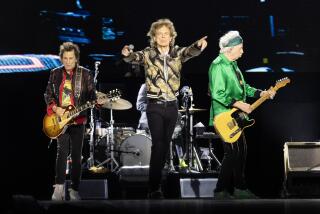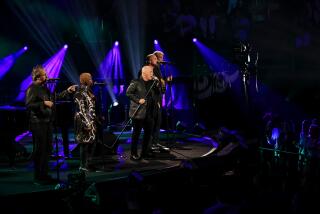Jagger Jolts Japan : Sans Stones, He Electrifies Teen-Age Fans
- Share via
TOKYO — Mick Jagger on stage without the Rolling Stones?
The celebrated rock singer’s first solo tour, which is limited to eight shows in Japan, could have been as much a potential mismatch as Tony (TNT) Tubbs’ stepping into the ring here last Sunday against heavyweight champion Mike Tyson.
The feuding and inactive Stones, who haven’t toured since 1982, rank as one of the two most acclaimed rock bands ever. But Jagger’s two recent solo albums were uneven works in the somewhat disappointing tradition of Paul McCartney’s early LPs after he left the Beatles.
Jagger also seemed on the last Stones tours occasionally to be playing down to the curious, teen-age crowd that was seeing the “legendary” Stones for the first time. It was as if Jagger--whose youthful arrogance and sexual independence in the ‘60s helped define the image of the rebellious rock ‘n’ roll singer--felt so obligated to reenact his young and scruffy days that he almost became a caricature of himself.
But Jagger proved here Tuesday and Wednesday that he was no Tony Tubbs.
In the same 50,000-capacity Tokyo Dome where Tyson annihilated his opponent over the weekend, Jagger delivered frequently spectacular shows before what several local observers described as the most responsive Tokyo audiences in memory.
For most of his two hours-plus on stage both nights, Jagger, 44, seemed like a man who had been liberated--from what may have been his own insecurities about his role in contemporary rock and, quite possibly, his Stones shackles.
Without sacrificing energy, Jagger exhibited a renewed sense of style as a performer as he moved with greater subtlety and purpose than on the recent Stones tours, and he showed increased maturity as a singer.
While relying heavily on Stones material, he no longer seemed like a man clinging rather desperately and anxiously to the past. This solo tour was a bold tumble of the dice, and Jagger--beyond most reasonable expectations--was a clear victor.
Don’t, however, expect to see this show soon in the United States.
In an interview before Wednesday’s concert, Jagger made it clear that his top priority remains getting together with the Stones for another album and concert trek.
About working again with the long-inactive Stones, he said: “I hope it works out. But I’m not going to give you any odds about when or where. (After all the public squabbling) we’ve decided that we weren’t going to speculate or talk about our future in public. . . . But I will say it seems it is going to take longer (to start things up) than I thought it would.”
Asked if his more comfortable and less self-conscious role on stage was a result of working away from the Stones, Jagger shrugged. “That’s probably just a sign of me finally growing up.”
“I wait 10 years to see Mick Jagger,” a 23-year-old Japanese fan said Tuesday as he stood in line outside the Tokyo Dome, a $269-million baseball stadium near the historic Imperial Palace grounds.
Yoshiro Moriyama said he would have preferred seeing all the Rolling Stones, who have never played here because of an inability to get visas due to drug-related incidents involving Jagger in the ‘60s and guitarist Keith Richard in the ‘70s. (Even after all these years, Jagger reported, it still took some serious governmental arm-twisting to enable him to get the necessary clearance.)
“I wish they were all here,” Moriyama said. “But if they can’t all come, Mick Jagger is my favorite, and I want to hear ‘Satisfaction.’ ”
It was that kind of longstanding anticipation among Japanese rock fans that enabled Jagger’s three-city tour to sell out instantly. More than 170,000 people will have seen the concert by the time the tour ends Monday with a performance in Osaka. With tickets scaled to $50 (standard for stadium shows here), the tour will gross an estimated $7.5 million.
The teen-age fans, the majority in an audience that also contained suited businessmen in their 40s, dressed like fans at U.S. rock shows: lots of jeans and an occasional baseball jacket.
Inside the Dome, the fans showed only passing interest in the souvenir T-shirts favored by U.S. concert-goers, while frequently buying two or three copies each of the lavishly colored $16 concert programs hawked by strolling vendors the way peanuts are sold at U.S. baseball games.
As the start of Tuesday’s concert neared, fans sat patiently, thumbing through their programs. The politeness of the crowd, which had stood in long, orderly lines, reinforced the Western stereotype about the passivity of Japanese rock crowds.
After both concerts, fans didn’t just get up and leave. They sat quietly in their seats until their section number was called, then got up and filed out.
On Tuesday Jagger attacked what he had expected to be the passive sensibilities of the audience.
With the houselights off during an instrumental jam by the band, Jagger slipped unnoticed through the aisles to a platform in the middle of the crowd that held an audio mixing board.
When the spotlight came on him during the start of “Gimme Shelter,” the Stones’ famous look at social and psychological chaos, hundreds of fans raced through the aisle and across chairs to be near him. After waiting years simply to see Jagger on the stage, these fans could suddenly touch him.
As ushers scrambled to restore order, Jagger stepped down from the platform and tried to make his way to the stage about 200 feet away. Though he was aided by a half-dozen bodyguards, there were times that his progress was not only impeded, but reversed by the crush of the crowd.
From then on, the fans--while staying obediently in front of their seats--danced and sang along with the passion and resolve of a Stones crowd anywhere.
About going into the audience Tuesday night, Jagger commented, “The funniest thing is, a lot of my friends in the business called me before I came here to kind of prepare me for what to expect.
“They talked about how quiet the fans are here and how they sat in their seats . . . and how it shouldn’t throw me off. ‘The fans are just reserved,’ everyone said.
“That’s why I thought it would be OK to go into the audience. But when I got out there all I saw was people coming at me and there was no place to go. The only thing I could think of was, ‘What’s all this stuff about everyone being reserved?’ ”
Jagger was sufficiently impressed by the aggressiveness of the Japanese fans that he didn’t repeat the stunt at Wednesday’s show. He did have another surprise for the crowd, though: Tina Turner joined him for spirited renditions of “Brown Sugar” and “It’s Only Rock ‘n’ Roll.”
It took a moment of adjustment for any Stones fan at the Dome when Jagger came on stage backed by a six-piece band and four backup singers in place of Keith Richard, Bill Wyman, Charlie Watts and Ron Wood.
But it sure sounded like the Rolling Stones when guitarist Jimmy Ripp played “Honky Tonk Women” in virtually the note-for-note sensuous style of Richard, and Jagger sang about that “barroom queen in Memphis” in his patented bluesy drawl.
From that moment, it was clear that this was no casual effort, but a carefully planned undertaking by a man who believes his career is on the line.
Jagger alternated between familiar Stones hits (from a celebrative “Satisfaction” to a highly stylized version of “Sympathy for the Devil”--complete with 50 masked dancers), a few surprises from the old catalogue (including the rarely performed “Ruby Tuesday”), songs from his solo LPs that reflect the Stones tradition (the sassy “Throwaway”) and songs from the solo works that touch on more socially conscious themes (“War Baby”) than found in the Jagger-Richard songbook.
While Jagger has enough of a history as a showman to have made one suspect his solo show would be an imaginative affair, the degree of ambition contained in this show was surprising: often dazzling lighting effects, imaginative use of video and cartoon images on video screens and some flashy choreography by the background singers/dancers.
Reviews in the local papers the next day were ecstatic: “Magnificent,” “Megaton rock . . . he explodes” and “Mick dives into the fans and they go absolutely crazy.”
After his two solo albums, Jagger very much seemed to need the Stones again, but the dramatic commercial and artistic triumph of these shows gives him options. If the Stones do tour, he will go back to the band as a more complete and mature preformer. If not, Jagger has in this show a potential winner, too.
“I feel real positive about what we’ve done on the tour,” he said. “It makes me feel I can go out on my own and do something that people will accept and that I will enjoy.
“But I wouldn’t necessarily do the show this way. This show was designed for a stadium. That’s why we did so many of the Stones hits. If I took the show down to a 10,000-seater, I’d experiment a little more, maybe a few more of my songs and a few of other peoples’.”
More to Read
The biggest entertainment stories
Get our big stories about Hollywood, film, television, music, arts, culture and more right in your inbox as soon as they publish.
You may occasionally receive promotional content from the Los Angeles Times.










